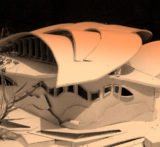
The Australian Pavillion
Di Stasio Ideas Competition Entry for a new Australian Pavilion at the Venice Biennale
The international ideas competition for an Australian Pavilion at the Venice biennale was organized in early 2008 by Rinaldo Di Stasio, owner of the Italian Cafe Di Stasio, to mark the occasion of the joint 20 year anniversary of the Melbourne Cafe and the Australian pavilion in Venice. The brief for the competition was very open and generated 446 registrations from around the world, resulting in 168 final entries. A panel of two architects and two artists shortlisted 56 of them in the first round, before making a smaller selection of finalists and choosing two winners from the professional and pre-professional categories. To check out some of the shortlisted and winning entries go to http://www.distasio.com.au/category/venice-pavilion/winners/
Our entry was submitted in joint names and represents the collaborative effort of Johannes Schuster and Alvyn Williams, director of Soft Loud House Architects. In the end it didn’t make it into the short list. The fact that we didn’t have access to high tech 3D computer graphics and used images of an only partially finished cardboard model (as a result of time pressure) probably didn’t help. However, regardless of competition place, the design process and its underlying principles are still valid in their own right. It therefore seemed appropriate to feature the pavilion here from a process point of view, as an example of the biosculptural approach to design.
The following sections describe the 4 steps of the creative process and the thoughts that led to the particular design of the pavilion.
- AIM
- FINDING THE CORE QUALITIES
- TRANSLATING QUALITIES INTO PHYSICAL FORM
- FORMING A PURPOSEFUL, LIVING WHOLE
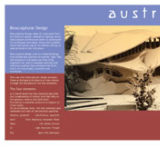
The Australian Pavillion
Venice Biennale Competition Entry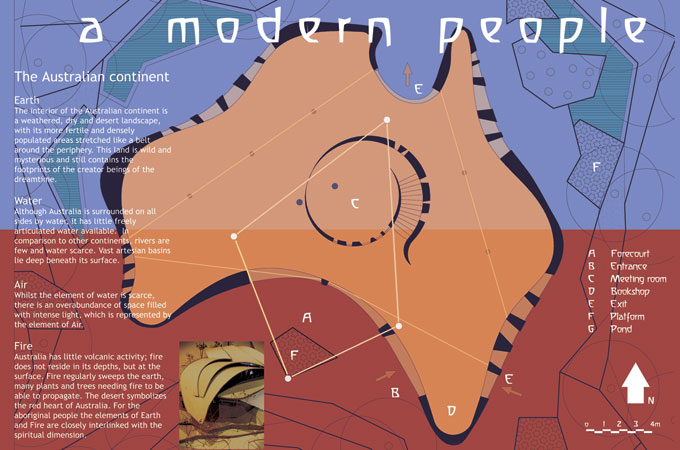
1) Aim
The Venice biennale showcases, on an international stage, the art and artists of a variety of countries, each of which has its own dedicated pavilion located in the exhibition precinct. We thought that in such a situation the pavilion itself should become an artistic statement and advertisement for the country it represents. This of course begs the question of what exactly it is that should be said and advertised.
From a European perspective Australia is “downunder”, on the opposite side of the world. But this is not the only “opposite”. If Europe occupies a central world stage, is relatively small but densely populated, Australia is remote, vast and with a population small enough to fit into greater London and Paris combined. All of which creates curiosity about a different way of life, mixed with a sense of the unknown.
The aim for the Australian pavilion therefore was to both, satisfy as well as amplify this sense of curiosity and mystery and leave the international visitor with a palpable impression of the special nature and uniqueness of Australia.
In short: the Australian pavilion should not only meet all the functional requirements of an exhibition space but should itself be an exhibit that coveys an impression of the “Spirit of Australia”.
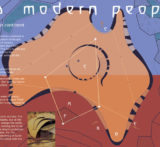
1) Aim
Venice Biennale Competition Entry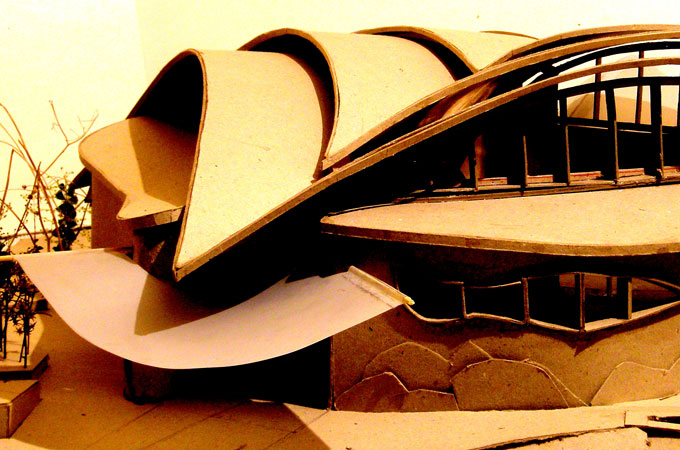
2) Core qualities
The next step is to find the Core Qualities that are to permeate the physical form of the building. The above aim begs again the obvious question: What is the “Spirit of Australia”? Whatever this spirit may be, it arises out of the mutual interaction of three essential factors:
1) The ancient land with its climate and geography
2) The ancient indigenous population with its history and culture
3) The migrant population of the last 200 years with its modern culture and consciousness
The land and its indigenous people are some of the most ancient in the world, as a modern nation Australia is one of the youngest countries in the world. This gave us the overall theme:
“AUSTRALIA: A MODERN PEOPLE IN AN ANCIENT LAND”
The next step is to find the qualities that are implied in the above factors and overall theme. Biosculptural Architecture works a lot with the qualities of the 4 Elements. This provides us with a helpful template through which typical qualities begin to reveal themselves.
In a literal sense the four elements describe the condensation of matter from the fiery to the gaseous, watery and solid state. Everything in material existence is subject to these states. On an archetypal level, the four elements also represent four equivalent sets of non-physical qualities. This was explained in an earlier section. The summarized qualities are again shown below:
| PHYSICAL ELEMENTS | EQUIVALENT NON-PHYSICAL QUALITIES |
| Earth | Solid Form, Resistance, Purposeful Whole |
| Water | Life, Motion, Emotion |
| Air | Light, Expansion, Thought |
| Fire | Spirit, Will, Motivation |
Lets therefore, through the perspective of the 4 Elements, take a look at the Australian continent and its ancient and modern people:
EARTH
The interior of the Australian continent is an ancient, weathered, dry and rugged desert landscape, with its more fertile and densely populated areas stretched like a green belt around the periphery. This land is hard, wild and mysterious and still contains the footprints of the ancient creator beings. In fact the land and its geographic features are but an outer expression of Aboriginal spirituality and the beings and creatures of the dream time. The indigenous population learnt to live with this land and has a deeply experienced connection with it. The modern settlers and migrants endured great hardship learning to cope with and to cultivate the land. Necessity taught them to become practical and resourceful and to shrug off tragedy and suffering with a dry comment and a larrikin sense of humor.
WATER
Although as an island Australia is surrounded by water, it has little freely articulated water of its own. In comparison to other continents, rivers are small and few, water is scarce and multiyear droughts are common. On the other hand vast artesian basins lie in its centre deep beneath the surface. The element of water is the outer, physical expression of what we experience on a non-physical level as the flow and movement of our feelings and emotions. Surprisingly this curious absence of the watery element in the Australian continent seems to have also left its mark on the psyche of its people, whose dry sense of humor and practical, down to earth approach to life is not easily given over to the kind of animated emotional styles of expression we might expect to find in southern Europe but would find “out of place” in the Australian outback. However, reticence or dryness of emotional expression shouldn’t of course be confused with a lack of emotional life or resources. Far from it. It takes a great deal of emotional resilience and stamina to persevere in the face of the back breaking work and hardships faced by the early pioneers and explorers. The watery element or emotional life is not lacking at all, it’s just hidden underneath a rugged looking surface layer, like the underground artesian basins in the heart of Australia.
AIR
The element of air is connected with light, which in turn is associated with thought and consciousness. There appears to be an archetypal synonymy between outer and inner light. Just like physical light becomes visible through the fact that it is being reflected from the surfaces of the environment, so our inner environment becomes visible to us when we “reflect” on it with the inner light of our thoughts. Whilst the element of water is scarce in the Australian landscape, there is an overabundance of light, air and open spaces. The horizons are vast, the air is hot and dry, the skies are clear and the light is bright and intense. Again we can draw an interesting parallel between the physicality of the land and the people living there. Australians are open minded, practical and perceptive. They are uncomplicated, quick-witted and sharp, with an irreverent attitude towards authority and a dislike of “tall poppies”. Australians are not prone to formalities and traditions, their approach is direct, to the point and quick on the give and take. Modern Australians are among the fastest to adopt new technologies and their experience with farming and mining have challenged them to come up with many new technologies and a great number of practical inventions. All of which amounts to an open, quick and practical mind, born as it were out of the need to adapt in order to survive and thrive in a hard and ancient land. The land is ancient and of the past, but the consciousness and cultural life of its migrant population is modern and directed to the future.
FIRE
The element of Fire is an expression of the spiritual element. We all can experience within us an individual spark and essence which represents the core of our being. Our internal fire is what motivates us into action. When this fire no longer burns we have lost the will to live. On a physiological level the element of “Fire” resides in our metabolic system, which burns up the fuel that supplies us with physical energy. On a geographical level, as one of the oldest continents Australia has little volcanic activity. Physical Fire does not reside in its depths, but at the surface. Fire regularly sweeps the earth, in fact many plants and trees need cyclic bushfires for their seeds to be able to propagate. The element of fire also lives in the red earth, red rock, and in the red sands, red iron and other metallic minerals of the outback. Uluru, the big red rock stands like a big red heart in the middle of the Australian desert. For the aboriginal people the elements of Earth and Fire are closely interlinked. Aboriginal spirituality does not dwell on far away cosmic abstractions but reveals itself behind every rock formation, animal and tree. There is still a gap of understanding today between the ancient spirituality of the land and its indigenous people and the modern spirituality and consciousness of the 21st century. It seems part of the destiny of Australia as a nation to bridge this gap.
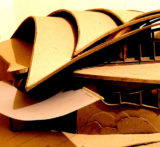
2) Core qualities
Venice Biennale Competition Entry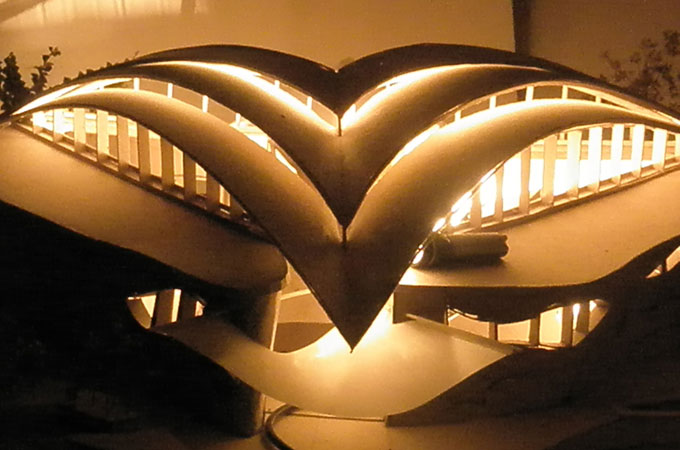
3) Finding Form
Having fleshed out some of the physical elements and non-physical qualities we associate with the “Spirit of Australia”, the next step is to begin translating these essential characteristics into physical form. We will use again the 4 Elements as our template:
EARTH
The Australian pavilion rises on top of a series of steps formed in the manner of contour lines, representing the Australian continental shelf. We have raised the floor level of the pavilion to allow for an internal lower level (explained in connection with the element of FIRE) and to be able to create an external approach designed and landscaped to reflect the red earth and ancient ruggedness of the Australian land mass.
WATER
The walls are all curved and meander around the building, following the stylized form of the Australian continent and coastline. They flow like a river, reflecting not only the fertile coastal belt, but also the creative processes of the great Rainbow Serpent, which is one of the central figures of aboriginal mythology and which represents the shaper of the land and guardian of the element of Water. Some of the upper windows invoke images of the Rainbow Serpent and other aquatic creatures of the dreamtime. The walls of course form the periphery of the building. On the Australian main land the periphery is where the majority of the population lives. The interior, as we know, is arid and scarcely populated. It is therefore very fitting to express the watery element and demographic life and profile of the nation within the alcoves and bays of the meandering walls. Having a floor plan that approximately matches the geographic footprint of the country also makes for interesting internal and external exhibition possibilities from a curator’s point of view.
AIR
We chose the shape of a bird’s wing to inspire the shape of the roof. A bird in flight is an image of grace filled movement within the element of Air and Light. The arcs of the wings in flight are molded by the currents of the air and are imbued with a quality of flexibility and lightness. This shape is also an outward picture of the qualities that are associated with thought, consciousness and freedom. In their ability to overcome gravity, birds symbolize freedom. Whatever outer constraints we may find ourselves in, we are free in our thoughts. In our thoughts and imagination we can roam and soar like a bird in the sky. A bird’s wing is designed to be carried by the air and at the same time it can play with the air and glide through and on top of air currents, spiraling into the heights and sailing over great distances. In the same way our thoughts can plumb the heights and the depths, survey the field and be carried by the thermals of the imagination and currents of knowledge. Clarity of thought or flashes of insight can cut through a problem like a bird’s wing slicing through the light filled air, fast and effortless.
The great white wings that form the roof of the pavilion are an expression of freedom of thought, of openness and flexibility and of the promise of the new consciousness of modernity that has come from abroad to create a new and inspiring future in an ancient land. From an architectural perspective the particular shape also allows for generous amounts of light to penetrate between the stepped roof sections, creating an interesting play of light and shade as well as the possibility of airy, light filled internal spaces.
FIRE
In the heart of the pavilion is a spiral shaped tower or meeting room. Its central location, decorative detail and colored glass windows evoke images of the aboriginal Bora Ring (meeting place). It is an expression of the red heart, spiritual core and fire within. Geometrically this room is located within the coordinates of the “Southern Cross” whose geometry is mirrored in the structural beams and within the footprint of the exhibition area. The round walls of this central space lead down via a spiral stair case to a lower level that is designed as a darkroom and multimedia presentation area. At the same time the walls also spiral up to the roof. In fact the whole room and its walls form the structural anchor point that carries and balances the spine of the roof. In this way the room not only forms the heart of the pavilion but it also becomes the connecting link between the roof above, the ground floor and the underground level below. Symbolically and simultaneously it penetrates down to the inner fire and to the watery element which in continental Australia lies hidden underground in large artesian basins, while at the same time reaching up to where its transparent roof sections meet the sky. From there direct sunlight floods down into this central room and heart of the pavilion from where it then filters out via colored windows into the main exhibition space.
How the various architectural features described here are more specifically connected with the element of Fire and the spiritual dimension is discussed further in the next section.
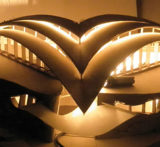
3) Finding Form
Venice Biennale Competition Entry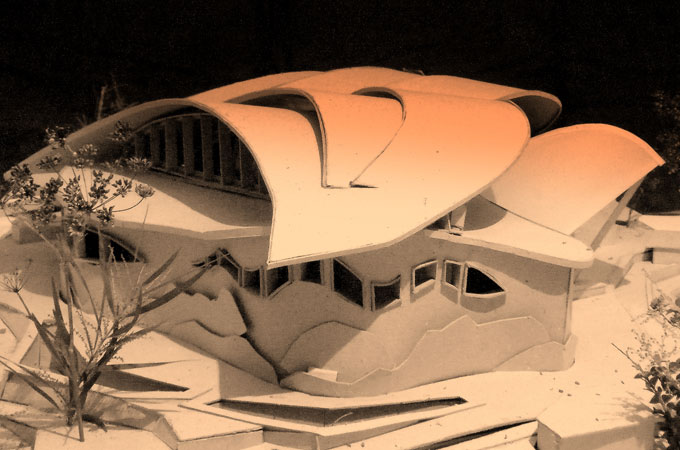
4) Living Whole
In the final step all elements need to come together to form a purposeful living whole.
A building only has artistic integrity and individual presence when all its various features and elements come together to form an interconnected whole. If the whole is able to give meaning and purpose to the individual parts we have the possibility of a living, breathing, inspiring work of art. If the various parts are thrown together without a common generative principle we get a bag of bones but never a viable skeleton. In living nature the skeleton contains the structural thoughts that have formed the species and there is always a perfect match between the outer form and the characteristics and personality of the species. In the realm of architecture we have to do it all ourselves, create the skeleton and match it with the characteristics and personality of the proposed new species so to speak. The point we are making, in a roundabout way, is that it is the skeleton which determines the essential form and, with the form, the potential and characteristics of the species.
What is the connection between skeleton and spirit? After all, without the presence of the living, soul/spiritual element even the most perfectly formed skeleton is little more than a bag of well placed bones. The connecting link between spirit and skeleton lies in the fact that both perform the same coordinating function, albeit on different levels of existence. Our spiritual core is that enduring part within us which integrates and places into context all our experiences, thoughts and emotions. As a result of this coordinating and integrating activity self consciousness and a sense of individual identity is able to form, develop and mature. People who lose their memories also lose their sense of identity. The physical skeleton has the same coordinating function with respect to the geography of our physical form. It places all the individual parts of our anatomy within a meaningful functioning context which we then are able to recognize as the physical identity of the particular species.
In the architectural context the same need for an interconnected physical and spiritual identity applies if we aim for a living, breathing, and potentially inspiring artistic whole.
In order to find the appropriate structural form for a building we must first have the inspiring thought which is able to imbue the future form with meaning. It is this very thought and essence which then becomes both: the generative and uniting principle. For the proposed Australian pavilion this principle was able to be expressed in the words: “Australia: a modern people in an ancient land” Everything is contained in this generating thought. From there on it was just a matter of fleshing out the details and arranging them appropriately within the emerging whole.
The words “a modern people in an ancient land” convey a true and succinct image of reality. In the space of only 200 years a new, western population with a western consciousness has super imposed itself on an ancient land and clashed with an indigenous population of a very different dream time consciousness. The meeting of the two civilizations was not an easy one and is characterized by violence, hardship and lack of understanding. The new migrant population may have succeeded in settling the continent but, on a deeper level, understanding of the land and of the way and spirit of its original inhabitants is still lacking. The western, science and technology dominated consciousness and the spirituality of the dream time have yet to meet and learn to understand each other. This juxtaposition of two very different types of consciousness and the need for them to connect with each other, is expressed in the structural form and design of the pavilion.
The roof represents the new consciousness but it is not yet fully integrated with the rest of the building. The arcs of the roof sit lightly on the walls, like a great white bird that has just landed after a long journey from foreign shores. There is however a deeper, structural connection between the roof and the “continent” or exhibition space below. As was explained in the previous section, the central room which represents both, the heart of the building and aboriginal spirituality rising up from the earth below, forms the connecting link and structural support that carries the roof. The meeting of the two very different types of consciousness is built into the very structure of the building and places everything else into context.
Ultimately therefore, the spiritual essence of the building comes to expression through its structural gesture, which is possibly the most fundamental principle underlying the method of Biosculptural Architecture.
******************************
Although of course this particular Australian pavilion was never built and is not likely to ever be built, I hope the above notes have been able to give an idea of the biosculptural aim and approach to architectural design.
